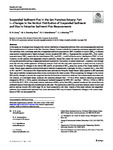Multi-annual embayment sediment dynamics involving headland bypassing and sediment exchange across the depth of closure
| dc.contributor.author | Valiente, NG | |
| dc.contributor.author | McCarroll, Jak | |
| dc.contributor.author | Masselink, Gerd | |
| dc.contributor.author | Scott, Tim | |
| dc.contributor.author | Wiggins, Mark | |
| dc.date.accessioned | 2019-07-30T13:19:41Z | |
| dc.date.available | 2019-07-30T13:19:41Z | |
| dc.date.issued | 2019-10-15 | |
| dc.identifier.issn | 0169-555X | |
| dc.identifier.issn | 1872-695X | |
| dc.identifier.uri | http://hdl.handle.net/10026.1/14716 | |
| dc.description.abstract |
Predicting the future behavior of beach and nearshore systems requires an accurate delineation and understanding of coastal cell boundaries, sediment transport pathways, and sediment sources and sinks. Unfortunately, there is a paucity of field datasets on beach and nearshore morphological change that extend fully from the top of the dunes to beyond the depth of closure to enable quantification of the sediment budget. Here, for the first time, we employ a total sediment budget approach, examining a sandy and embayed beach located in the north coast of SW England, to investigate inter- and multi-annual embayment scale sediment dynamics over a 10-year period that includes extreme storm erosion and post-storm recovery. We demonstrate that, despite the deeply embayed nature of the beach, the shoreline orientation roughly parallel to the dominant wave direction and the overwhelmingly cross-shore forcing of the inter-tidal beach volume, the system is neither closed, nor balanced. The very significant net changes in the recorded sediment volume from dune top to depth of closure (−14.5 m ODN), representing a loss of c. 100 m3 m−1 during the extreme storm period and a gain of c. 200 m3 m−1 during the recovery period, indicate that significant sediment transport occurs seaward of the base of the terminating headlands and beyond the morphological depth of closure. The results further indicate that the inter-tidal region is partly uncoupled from the sub-tidal region, with the former region dominated by cross-shore sediment fluxes, whereas the subtidal region is also significantly affected by longshore sediment fluxes. A conceptual model is presented that balances the observed volume changes with inferred fluxes, forced by variations in total and alongshore wave power. This study contradicts the general assumption that when sediment exits the inter-tidal, it rests undisturbed in the sub-tidal, waiting for a period of low-moderate energy to bring it onshore. The large sediment volumetric variations across the lower shoreface (depth of 5–20 m), which are of the same order of magnitude as, but uncorrelated with, those occurring in the inter-tidal region, are suggestive of an energetic longshore transport system across this deeper region. It is possible that this transport system extends along the whole north coast of SW England and this finding may lead to a shift in understanding of sediment budgets along exposed and macrotidal embayments globally. | |
| dc.format.extent | 48-64 | |
| dc.language | en | |
| dc.language.iso | en | |
| dc.publisher | Elsevier | |
| dc.subject | Storm response | |
| dc.subject | Sediment budget | |
| dc.subject | Beach recovery | |
| dc.subject | Sediment dynamics | |
| dc.subject | Nearshore sediment transport | |
| dc.subject | Beach morphodynamics | |
| dc.title | Multi-annual embayment sediment dynamics involving headland bypassing and sediment exchange across the depth of closure | |
| dc.type | journal-article | |
| dc.type | Journal Article | |
| plymouth.author-url | https://www.webofscience.com/api/gateway?GWVersion=2&SrcApp=PARTNER_APP&SrcAuth=LinksAMR&KeyUT=WOS:000483646300005&DestLinkType=FullRecord&DestApp=ALL_WOS&UsrCustomerID=11bb513d99f797142bcfeffcc58ea008 | |
| plymouth.volume | 343 | |
| plymouth.publication-status | Published | |
| plymouth.journal | Geomorphology | |
| dc.identifier.doi | 10.1016/j.geomorph.2019.06.020 | |
| plymouth.organisational-group | /Plymouth | |
| plymouth.organisational-group | /Plymouth/Faculty of Science and Engineering | |
| plymouth.organisational-group | /Plymouth/Faculty of Science and Engineering/School of Biological and Marine Sciences | |
| plymouth.organisational-group | /Plymouth/REF 2021 Researchers by UoA | |
| plymouth.organisational-group | /Plymouth/REF 2021 Researchers by UoA/UoA07 Earth Systems and Environmental Sciences | |
| plymouth.organisational-group | /Plymouth/Research Groups | |
| plymouth.organisational-group | /Plymouth/Research Groups/Marine Institute | |
| plymouth.organisational-group | /Plymouth/Users by role | |
| plymouth.organisational-group | /Plymouth/Users by role/Academics | |
| plymouth.organisational-group | /Plymouth/Users by role/Researchers in ResearchFish submission | |
| dcterms.dateAccepted | 2019-06-28 | |
| dc.rights.embargodate | 2020-7-3 | |
| dc.identifier.eissn | 1872-695X | |
| dc.rights.embargoperiod | Not known | |
| rioxxterms.version | Accepted Manuscript | |
| rioxxterms.versionofrecord | 10.1016/j.geomorph.2019.06.020 | |
| rioxxterms.licenseref.uri | http://www.rioxx.net/licenses/all-rights-reserved | |
| rioxxterms.licenseref.startdate | 2019-10-15 | |
| rioxxterms.type | Journal Article/Review | |
| plymouth.funder | Physical and biological dynamic coastal processes and their role in coastal recovery (BLUE-coast)::NERC | |
| plymouth.funder | Physical and biological dynamic coastal processes and their role in coastal recovery (BLUE-coast)::NERC |



